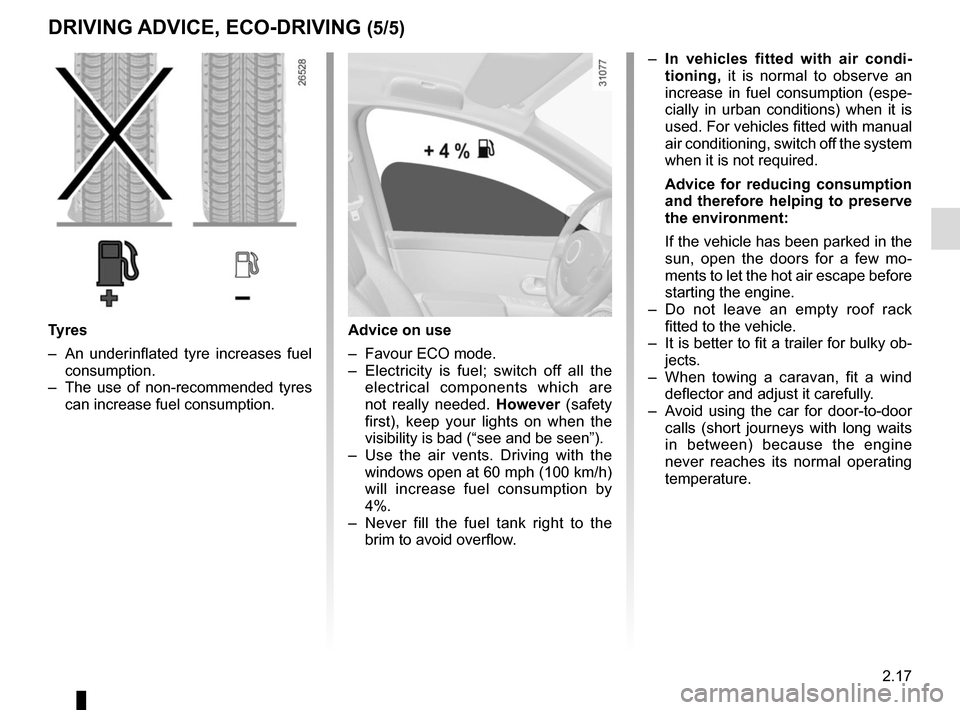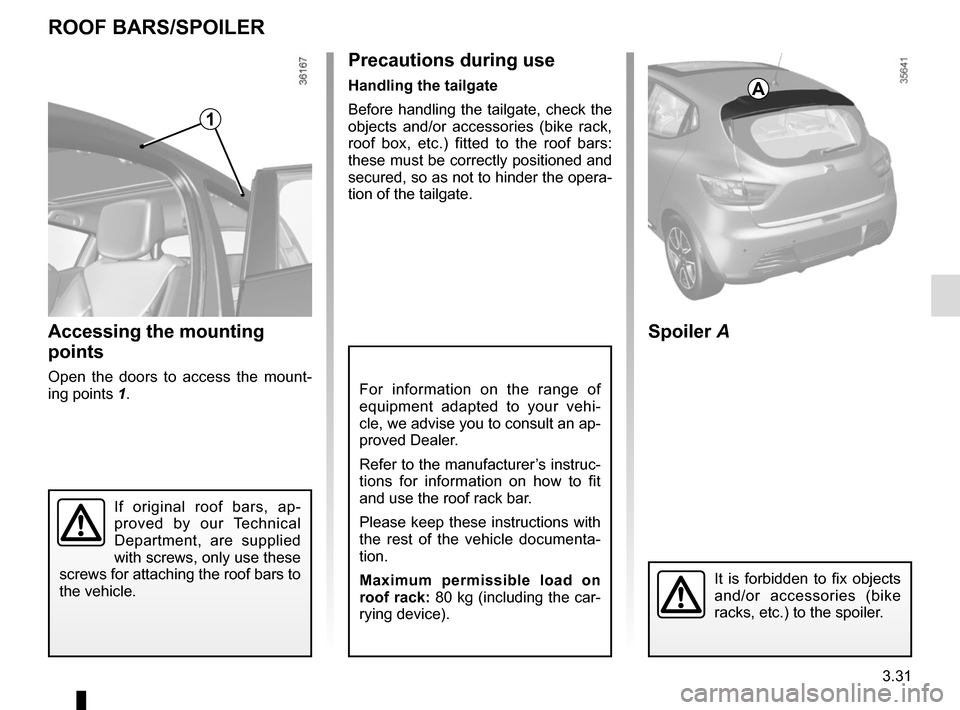2016 RENAULT CLIO SPORT TOURER roof rack
[x] Cancel search: roof rackPage 109 of 258

2.17
DRIVING ADVICE, ECO-DRIVING (5/5)
Advice on use
– Favour ECO mode.
– Electricity is fuel; switch off all the electrical components which are
not really needed. However (safety
first), keep your lights on when the
visibility is bad (“see and be seen”).
– Use the air vents. Driving with the windows open at 60 mph (100 km/h)
will increase fuel consumption by
4%.
– Never fill the fuel tank right to the brim to avoid overflow.
– In vehicles fitted with air condi-
tioning, it is normal to observe an
increase in fuel consumption (espe-
cially in urban conditions) when it is
used. For vehicles fitted with manual
air conditioning, switch off the system
when it is not required.
Advice for reducing consumption
and therefore helping to preserve
the environment:
If the vehicle has been parked in the
sun, open the doors for a few mo-
ments to let the hot air escape before
starting the engine.
– Do not leave an empty roof rack fitted to the vehicle.
– It is better to fit a trailer for bulky ob- jects.
– When towing a caravan, fit a wind deflector and adjust it carefully.
– Avoid using the car for door-to-door calls (short journeys with long waits
in between) because the engine
never reaches its normal operating
temperature.
Tyres
– An underinflated tyre increases fuel consumption.
– The use of non-recommended tyres can increase fuel consumption.
Page 167 of 258

3.31
For information on the range of
equipment adapted to your vehi-
cle, we advise you to consult an ap-
proved Dealer.
Refer to the manufacturer’s instruc-
tions for information on how to fit
and use the roof rack bar.
Please keep these instructions with
the rest of the vehicle documenta-
tion.
Maximum permissible load on
roof rack: 80 kg (including the car-
rying device).
Precautions during use
Handling the tailgate
Before handling the tailgate, check the
objects and/or accessories (bike rack,
roof box, etc.) fitted to the roof bars:
these must be correctly positioned and
secured, so as not to hinder the opera-
tion of the tailgate.
ROOF BARS/SPOILER
A
Spoiler A
Accessing the mounting
points
Open the doors to access the mount-
ing points 1.
If original roof bars, ap-
proved by our Technical
Department, are supplied
with screws, only use these
screws for attaching the roof bars to
the vehicle.
It is forbidden to fix objects
and/or accessories (bike
racks, etc.) to the spoiler.
1
Page 254 of 258

7.4
ALPHABETICAL INDEX (4/5)
P
paintworkmaintenance ..................................................... 4.13 – 4.14
parking distance control.......................................... 2.38 – 2.39
power-assisted steering.................................................\
.... 1.51
pretensioners .........................................................1\
.24 → 1.27
puncture.......................................... 5.2 → 5.5, 5.9, 5.11 – 5.12
R
radio...................................................................\
................ 3.32
rear bench seat.........................................................\
......... 3.22
rear parcel shelf ................................................................. 3.24
rear seats..............................................................\
............. 1.22 functions ..............................................................\
........ 3.22
rear view mirrors ................................................................ 1.75
RENAULT ANTI-INTRUDER DEVICE (RAID) ................... 1.15
RENAULT card battery ................................................................\
.......... 5.26
use ................................................... 1.2 → 1.10, 2.3 → 2.5
RENAULT card battery ...................................................... 5.26
replacement parts ................................................................ 6.8
reverse gear selecting ..............................................................\
......... 2.12
reversing sensor ..................................................... 2.38 – 2.39
roof bars ........................................................................\
.... 3.31
roof rack roof bars ....................................................................... 3.31
running in ........................................................................\
..... 2.2
S
seat belt pretensioners front seat belt ...................................................1.24 → 1.27
seat belts ......................................................1.20 → 1.27, 1.30
service sheets..........................................................\
6.9 → 6.14
side protection devices ...................................................... 1.29
signals and lights ...................................................1.76 → 1.80speakers
location ...............................................................\
......... 5.34
special features of diesel versions.....................................\
2.11
special features of petrol vehicles ..................................... 2.10
speed limiter .................................................1.59, 2.31 → 2.33
starting the engine .....................................................2.3 → 2.9
steering wheel adjustment .............................................................\
...... 1.51
Stop & Start ......................................................1.59, 2.6 → 2.9
Stop & Start function..................................................2.6 → 2.9
stopping the engine ...................................................2.3 → 2.5
storage compartment.............................................3.16 → 3.19
storage compartments ...........................................3.16 → 3.19
sun visor ........................................................................\
.... 3.14
switching on the vehicle ignition ................................2.3 → 2.5
T
tailgate ........................................................... 3.23, 3.26 – 3.27
tanks and reservoirs brake fluid ...................................................................... 4.8
coolant ................................................................\
........... 4.7
tanks and reservoirs: windscreen washer ........................................................ 4.9
technical specifications ..............................................6.4 → 6.8
telephone ..............................................................\
............. 3.32
temperature regulation ............................................ 3.7 → 3.11
tool kit ........................................................................\
.......... 5.9
towing breakdown ........................................................ 5.38 – 5.39
towing equipment ......................................................... 3.28
towing a caravan ........................................................ 3.28, 6.7
towing equipment fitting ................................................................\
............ 3.28
towing hitch...................................................... 5.9, 5.38 – 5.39
towing rings ............................................................ 3.26 – 3.27
towing weights ..................................................................... 6.7